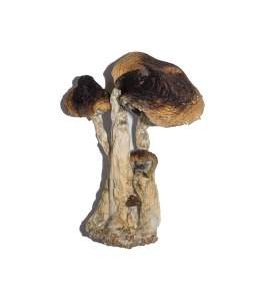SOUTH AMERICAN MAGIC MUSHROOM
$120.00 – $1,150.00
SOUTH AMERICAN MAGIC MUSHROOM
SOUTH AMERICAN MAGIC MUSHROOM
Many types of mushrooms produce psilocybin (4-phosphoryloxy-N,N-dimethyltryptamine), a secondary metabolite based on indole.
Teonanacatl, or “god’s flesh,” was the term used by the Aztec Indians of South America to describe them, and they were utilized in religious and therapeutic rites.
Throughout the 1500s, Spanish missionaries made an effort to obliterate any documentation or proof that these mushrooms were being used.
However, teonanacatl was brought up by a Spanish Franciscan friar and historian in the 16th century in his vast works, which piqued the interest of ethnopharmacologists in the 20th century and started a multi-decade quest to identify teonanacatl.
Their investigation eventually produced a 1957 photo-essay that was published in a popular magazine and explained how these mushrooms were used in the West.
In the end, specimens were acquired, and its active ingredient was discovered and chemically produced.
Over the last ten to fifteen years, numerous FDA-approved clinical trials have suggested that psilocybin-assisted psychotherapy may have therapeutic benefits in the treatment of anxiety, depression, and specific addictions.
Now, psilocybin is set to have a big impact on the treatments available in psychiatric care, assuming that further investigations can validate the early clinical findings.
One type of psychedelic mushroom in the Hymenogastraceae family is called Psilocybe yungensis.
It can be found in northeastern, central, and southeast Mexico in North America. It has been reported from Bolivia, Ecuador, and Colombia in South America.
It is also well-known in China and on the Caribbean island of Martinique. On decaying wood, the mushroom develops in groups or clusters.
The fruit bodies are atop slender stems that are from 3 to 5 cm (1.2 to 2.0 in) long, with conical to bell-shaped reddish- to orangish-brown caps that have a diameter of up to 2.5 cm (1.0 in).
When injured, the mushrooms become blue, which is a sign that the chemical psilocybin is present. The Mazatec Indians of the Mexican State of Oaxaca employ psilocybe yungensis for entheogenic uses.

| Quantity | Oz, Qp, Hp, Lb |
|---|
Reviews
There are no reviews yet.
Related products
Pills
Magic Mushrooms
Psychedelics
Psychedelics
Magic Mushrooms
Magic Mushrooms
Magic Mushrooms
Magic Mushrooms









Be the first to review “SOUTH AMERICAN MAGIC MUSHROOM”